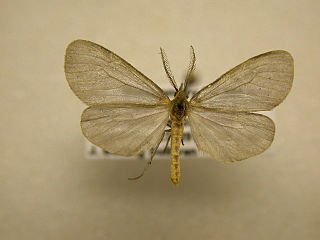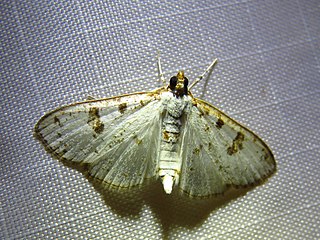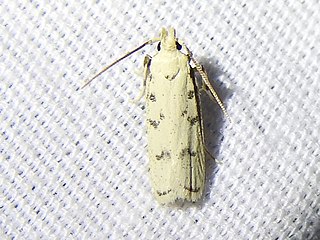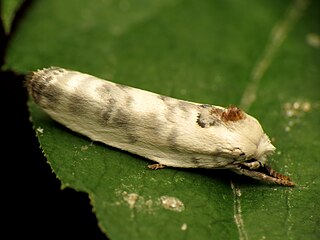
The Seminole bat is a species of bat in the family Vespertilionidae.

Pagara is a monotypic moth genus in the family Erebidae. Its only species, Pagara simplex, the mouse-colored lichen moth, is found in North America, where it has been recorded from Alabama, Arkansas, Florida, Georgia, Illinois, Indiana, Iowa, Kansas, Kentucky, Maryland, Mississippi, New Hampshire, North Carolina, Ohio, Oklahoma, South Carolina and Tennessee. Both the genus and species were described by Francis Walker in 1856.
Geshna is a monotypic moth genus of the family Crambidae described by Harrison Gray Dyar Jr. in 1906. It contains only one species, Geshna cannalis, the lesser canna leafroller, described by Altus Lacy Quaintance in 1898. It is found in North America, where it has been recorded from Florida, Mississippi, South Carolina, North Carolina and Tennessee. It has also been recorded from Costa Rica and Cuba.

Schinia nubila, the camphorweed flower moth or brown flower moth, is a moth of the family Noctuidae. The species was first described by Herman Strecker in 1876. It is found from the US states of Oklahoma to New Jersey, south to Florida and Texas. Its range is expanding in the northeast. Furthermore, recorded from Colorado, Kansas, Oklahoma, Arkansas, North Carolina, South Carolina and Maryland.
Spilosoma latipennis, the pink-legged tiger moth, or the red-legged diacrisia, is a moth in the family Erebidae. It was described by Richard Harper Stretch in 1872. It is found in eastern North America, where it has been recorded from Georgia, Indiana, Iowa, Kansas, Kentucky, Maine, Maryland, New Brunswick, New York, North Carolina, Ohio, Ontario, Pennsylvania, South Carolina, West Virginia and Wisconsin.

Elophila gyralis, the waterlily borer moth, is a moth in the family Crambidae. It was described by George Duryea Hulst in 1886. It is found in eastern North America, where it has been recorded from Alabama, Florida, Georgia, Illinois, Indiana, Iowa, Louisiana, Maine, Maryland, Massachusetts, Michigan, Minnesota, Mississippi, New Brunswick, New Hampshire, New Jersey, New York, North Carolina, Nova Scotia, Ohio, Oklahoma, Ontario, Pennsylvania, Quebec, South Carolina, Tennessee, Texas and Wisconsin.

Nemapogon clematella, the barred white clothes moth, is a moth of the family Tineidae. It is found in most of Europe and in North America, where it has been recorded from Maryland and North Carolina. The habitat consists of woodlands.

Diacme adipaloides, the darker diacme moth, is a moth in the family Crambidae. It was described by Augustus Radcliffe Grote and Coleman Townsend Robinson in 1867. It is found in North America, where it has been recorded from Alabama, Arkansas, Florida, Indiana, Maine, Maryland, Massachusetts, Michigan, Minnesota, New Brunswick, New Hampshire, New Jersey, New York, North Carolina, Nova Scotia, Ohio, Oklahoma, Ontario, Quebec, South Carolina, Tennessee, Texas, Virginia, West Virginia and Wisconsin. Adults have been recorded year round.

Arogalea cristifasciella, the stripe-backed moth, is a moth of the family Gelechiidae. It is found in North America, where it has been recorded from Alabama, Arkansas, Connecticut, Florida, Georgia, Illinois, Indiana, Kansas, Kentucky, Louisiana, Maine, Maryland, Massachusetts, Michigan, Mississippi, Missouri, New Hampshire, New Jersey, New York, North Carolina, Ohio, Oklahoma, Ontario, Quebec, South Carolina, Tennessee, Texas, Virginia, West Virginia and Wisconsin.

Diastictis argyralis, the white-spotted orange moth, is a moth in the family Crambidae. It was described by Jacob Hübner in 1818. It is found in North America, where it has been recorded from Colorado, Florida, Georgia, Indiana, Maine, Maryland, Mississippi, North Carolina, Ohio, Ontario, South Carolina, Tennessee, Texas and Virginia.

Glyphodes pyloalis, the lesser mulberry snout moth, lesser mulberry pyralid or beautiful glyphodes moth, is a moth in the family Crambidae. It was described by Francis Walker in 1859. It is found in Iran, China, Japan, India, Indonesia (Sumatra), Sri Lanka, Taiwan, the Democratic Republic of the Congo, Equatorial Guinea, Mozambique and North America, where it has been recorded from Florida, Maryland, North Carolina, South Carolina and Virginia.

Hyperstrotia secta, the black-patched graylet moth, is a moth of the family Erebidae. The species was first described by Augustus Radcliffe Grote in 1879. It is found in North America, where it has been recorded from Alabama, Arkansas, Florida, Georgia, Illinois, Indiana, Kentucky, Louisiana, Maryland, Massachusetts, Mississippi, New Hampshire, New Jersey, New York, North Carolina, Ohio, Oklahoma, South Carolina, Tennessee, Virginia and West Virginia.

Macaria minorata, the minor angle moth, is a moth of the family Geometridae. The species was first described by Alpheus Spring Packard in 1873. It is found in North America, where it has been recorded from Nova Scotia to Ontario, Quebec, Minnesota, New England, Maryland, North Carolina, South Carolina and Georgia.

Metalectra tantillus, the black fungus moth, is a moth of the family Erebidae. The species was first described by Augustus Radcliffe Grote in 1874. It has been recorded from the US states of Alabama, Florida, Georgia, Illinois, Iowa, Kentucky, Maryland, Mississippi, New Jersey, North Carolina, Ohio, Oklahoma, Pennsylvania, South Carolina, Tennessee, Texas, West Virginia and Wisconsin.

Pococera expandens, the striped oak webworm moth or double-humped pococera moth, is a moth of the family Pyralidae. It is found in North America, where it has been recorded from Arizona, Arkansas, British Columbia, Georgia, Illinois, Indiana, Iowa, Kentucky, Louisiana, Maine, Manitoba, Maryland, Massachusetts, Mississippi, New Brunswick, New Hampshire, New Jersey, New York, North Carolina, Ohio, Oklahoma, Ontario, Pennsylvania, Quebec, South Carolina, Tennessee, Texas, Virginia, West Virginia and Wisconsin.

Palpita illibalis, the inkblot palpita moth, is a moth in the family Crambidae. It was described by Jacob Hübner in 1818. It is found in North America, where it has been recorded from Alabama, Florida, Georgia, Maryland, Mississippi, North Carolina, Ohio, Oklahoma, Pennsylvania, South Carolina, Tennessee, Virginia and West Virginia.

Hydriomena transfigurata, the transfigured hydriomena moth, is a moth of the family Geometridae. It is found in North America, where it has been recorded from Alberta, Florida, Georgia, Indiana, Iowa, Kentucky, Maine, Manitoba, Maryland, Massachusetts, Minnesota, Missouri, New Brunswick, New Hampshire, New Jersey, New York, Newfoundland, North Carolina, Nova Scotia, Ohio, Oklahoma, Ontario, Quebec, South Carolina, Vermont, West Virginia and Wisconsin.
Coleotechnites canusella, the banded jack-pine needleminer moth, is a moth of the family Gelechiidae. It is found in North America, where it has been recorded from British Columbia, Washington, Alabama, Arizona, Louisiana, New Mexico and South Carolina.

Glyphidocera lactiflosella, the five-spotted glyphidocera moth, is a moth in the family Autostichidae. It was described by Vactor Tousey Chambers in 1878. It is found in North America, where it has been recorded from Alabama, Arkansas, Florida, Georgia, Louisiana, Maine, Mississippi, North Carolina, South Carolina, Tennessee and Texas.

Antaeotricha leucillana, the pale gray bird-dropping moth, is a moth in the family Depressariidae. It was described by Philipp Christoph Zeller in 1854. It is found in North America, where it has been recorded from New Hampshire, Massachusetts, New York, Pennsylvania, District of Columbia, Virginia, North Carolina, Georgia, Alabama, Arkansas, Missouri, Kansas, Illinois, Iowa, Texas, Oregon, Louisiana, Manitoba and Nova Scotia.
















